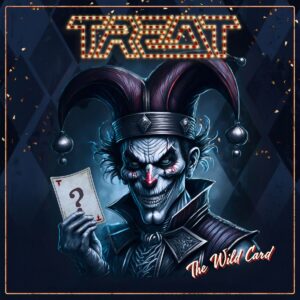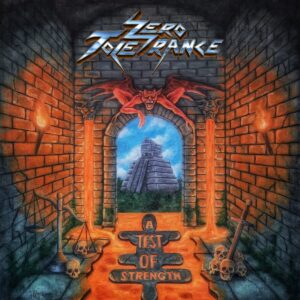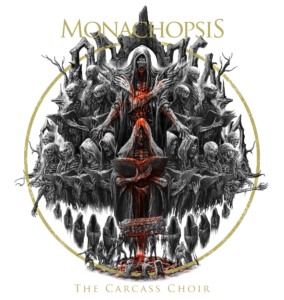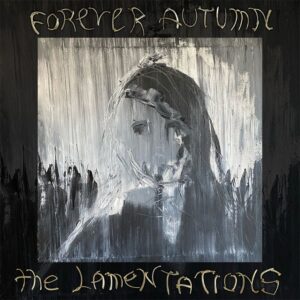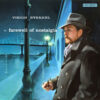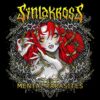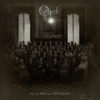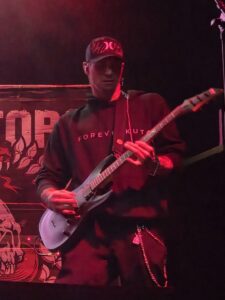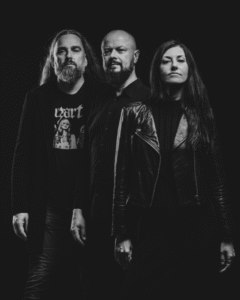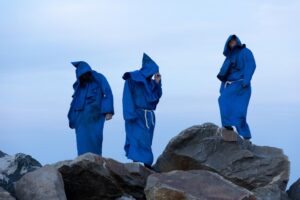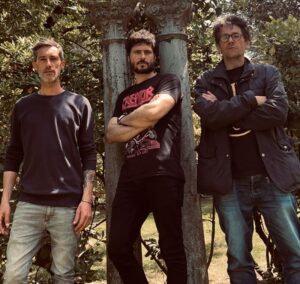Alexander Julien
Triskalyon
•
January 11, 2023

My name is Alexander Julien. I was born on January 15, 1988, in the Cote-Des-Neiges district of Montreal, Quebec, Canada, but I grew up in Edison, New Jersey, United States. I started playing electric guitar in December 2002 and have played in several bands, including Les Rocker's, The Slopin Fairy 7, The Tom & Alex Project, Scapegoat, Throne Of Mortality, Projection Mina, Soufferance, Vision Solitude, Vision Lunar, Vision Eternel, Gallia Fornax, Human Infect, Green Territory, Lanterns Awake, Éphémère, Citadel Swamp and Murder On Redpath.
I was also one of the founding members of the Triskalyon music collective and the record label Mortification Records. I later formed my own record label, Abridged Pause Recordings, and several related imprints, including Abridged Pause Publishing, Abridged Pause Productions, Abridged Pause Apparel and Abridged Pause Blog, which are (modestly) operated through the umbrella corporation, Abridged Pause Enterprises. For several years, I worked for U-Iliot Records, Klink Publishing and Klink Productions, which are music companies that were established in the early 1990s by my uncle Stephane Fania. Since 2007, I have operated two unassuming home-based recording studios: Mortified Studio in Edison, New Jersey, United States, and Mortified Studios in Montreal, Quebec, Canada.
Outside of making music, I work as a researcher, archivist and biographer in the film and music industries. I help with research on biographies of bands, record labels, film production companies, and old Hollywood celebrities. I occasionally write biographies myself, and have contributed to several webzines and album reissues as both a music interviewer and a biographer. I have a genuine passion for research and spend most of my non-music-making free time doing so, specifically tracking down old tour dates for bands.
Triskalyon sprouted from an idea that Aurélien Esnault and I had around July 2006. He and I had co-founded the Street Metal Forum earlier that year, which was dedicated to intelligently and scientifically researching the works of Les Légions Noires, a French black metal circle (more on this later in the interview). We were fascinated by Les Légions Noires and often expressed our desire to start our own black metal circle. There were already several circles imitating (or pretending to be affiliated with) Les Légions Noires in activity at that time, but unlike those that merely copied the aesthetics, we wanted to stand on our own merit. We were not trying to be like Les Légions Noires, we were just influenced by it. Still, we did take many cues from Les Légions Noires and comparisons over the years have not been entirely inappropriate. The majority of Triskalyon's members more-or-less took Les Légions Noires' black metal circle concept and made it their own, but I am afraid that I have to concede that some of our more impressionable (and less active) members along the way did not try very hard to create unique identities.
In addition to Les Légions Noires, I was also familiar with other music circles, or music collectives, outside of the black metal scene. They are very prominent in rap and hip-hop scenes. There was Team Nowhere in France, H8000 in Belgium (not rap but thug-style guys), Le 83 in Canada, and then in the United States there were D12, St. Lunatics, Wu-Tang Clan, and many others. Rap collectives were noted for collaborative efforts between its members, unlike most black metal circles that merely grouped a selection of bands. I was no longer listening to rap music by 2006 (with the exception of a handful of hip-hop artists linked to Mike Patton), so I do not want to give the impression that we were directly influenced by that type of collective. We were definitely a black metal circle, but I think that some of the rap collectives' ethics were inherently there. There was more unity within rap collectives than black metal circles.
After about a month of discussion, Esnault and I were finally able to launch Triskalyon when we met Eric Bryant, another member of the Street Metal Forum. The three of us co-founded Triskalyon in August 2006. Esnault was based in France and was then playing in the black metal band Unkwiss; Bryant was based in the United States and was then playing in the black metal band Mortifier; and I was traveling back and forth between the United States and Canada and was then playing in the black metal band Throne Of Mortality. The other members of our bands were also inducted as members of Triskalyon.
None of the original three members had solo projects at that time. This was something that we quickly developed as a direct influence from Les Légions Noires. At that time, the consensus was that all Les Légions Noires-related solo projects were officially named Project something (such as Project Moëvöt, Project Satanicum Tenebrae, Project Belathauzer, etc.), but this was later proved to be inaccurate through our research on the Street Metal Forum. But because of that original belief, we agreed that all Triskalyon-related solo projects would be named Vision something. I was the first to start a solo project specifically for Triskalyon, Vision Sufferance (later renamed Soufferance), though technically, Hunter O'Rourke, who joined as a member of Mortifier, had already started his solo project, Death Kvlt, before joining.
The goal of Triskalyon was to bring unity and strength to underground black metal and dark ambient bands and artists. It was created as a bank of creative talent, so that we could all help each other out on artistic projects. Not only as full collaborations (which ultimately never thoroughly happened), but in smaller ways, like composing music and writing lyrics, playing any number of instruments and vocal styles, and helping with recording or mixing. If one member was working on a solo project and needed drums, but could not play them, another member would come in as a session musician. If someone wrote all of the music and needed lyrics or poetry, he would approach another member whom he knew was apt in that field. If one had difficulty mixing a song, another member would help out. This was not to be limited solely to the music itself but also with album artworks and layouts, photography, videos and web design. We wanted to be self-sufficient to put together a complete artistic package within our circle.
Since the idea was that multiple people would be contributing to any number of projects (again, to an extent, like Les Légions Noires), it was also understood that everyone in the circle would also help to finance, press, release, distribute, and promote all Triskalyon-related releases. Not only the people involved in said release, but everyone as a unit. That good-will concept vanished almost immediately, as Esnault and I were left to split all of the work between ourselves. Most of the audible art was composed and recorded by me, while most of the visual art was designed by Esnault. I also took on the responsibility of managing Triskalyon's online presence and acted as the web designer and webmaster.
Esnault and I tried very hard during the circle's span to bring unity, and we really wanted the members to start collaborations. He and I were the only ones to successfully launch that with Gallia Fornax (though that was cut short by the circle's break-up). I was also hoping to book Triskalyon showcases, where multiple bands from the circle would play concerts together. But no one was ready to play outside of their little towns, and many of the acts were what you would call "bedroom projects", without ambition of ever playing concerts. The distance between members was not a problem that worried us because with internet communication and digital recording, everything could be done remotely. However, never being able to meet up, and the difficulty in booking shows was indeed a problem.
This is, to the best of my recollection, a comprehensive and archival list of everyone who has, at one time or another, been a member of the Triskalyon circle. I am naming names! It includes members' location of residence (at the time), span in the circle, and pseudonyms used (since we wanted to remain true to black metal expectations). There are, unfortunately, two members whose names I cannot recall and whom I was never able to track down during my extensive archival research project several years ago. Their names have been lost to time.
Musicians:
Alexander Julien aka Virkelig Død / Virkelix
Based in Montreal, Quebec, Canada / Edison, New Jersey, United States
Span: August 2006 - March 2007
Aurélien Esnault aka Der.Walsch / Lansquenet
Based in Angers, Pays-De-La-Loire, France
Span: August 2006 - March 2007
Eric Bryant aka Iskyros
Based in Culpeper, Virginia, United States
Span: August 2006 - November 2006
Hunter O'Rourke aka Thanatos
Based in Culpeper, Virginia, United States
Span: August 2006 - October 2006
Robert Decca aka Hellmallets
Based in Culpeper, Virginia, United States
Span: August 2006 - October 2006
Laurent - aka ???
Based in Angers, Pays-De-La-Loire, France
Span: August 2006 - November 2006
Dániel Czakó aka Gaeheln Tuhlv
Based in Miskolc, Borsod-Abaúj-Zemplén, Hungary
Span: August 2006 - October 2006
Austin Bennett aka Massacre
Based in Culpeper, Virginia, United States
Span: October 2006
??? aka ???
Based in Egypt
Span: October 2006 - November 2006
Adam Stergis aka Armaggedon
Based in Culpeper, Virginia, United States
Span: October 2006
Philip Altobelli aka Darklink
Based in Elizabeth, New Jersey, United States
Span: January 2007 - February 2007
David Parks
Based in Calgary, Alberta, Canada
Span: January 2007
James Shepard aka Suhrim
Based in Warrenton, Virginia, United States
Span: January 2007 - February 2007
Michael Lachaire aka Peine
Based in Edison, New Jersey, United States
Span: January 2007 - March 2007
Patrick Pelletier aka Monarque / Monarkh
Based in Quebec City, Quebec, Canada
Span: January 2007
Louis-Claude Roux aka LCR
Based in Pays-De-La-Loire, France
Span: February 2007 - March 2007
Jon Cumiskey aka Mr. T. S. Kettleburner
Based in Leeds, West Yorkshire, England
Span: February 2007 - March 2007
Katie Stone aka Katheryne, Queen Of The Ghosts
Based in Leeds, West Yorkshire, England
Span: February 2007 - March 2007
Daniel Eyre aka Mister Curse
Based in Leeds, West Yorkshire, England
Span: February 2007 - March 2007
Richard Blakelock aka The Gentleman
Based in Leeds, West Yorkshire, England
Span: February 2007 - March 2007
Bands and Projects:
Throne Of Mortality
Genre: Black Metal
Span: August 2006 - January 2007
Unkwiss
Genre: Black Metal
Span: August 2006 - January 2007
Mortifier
Genre: Black Metal
Span: August 2006 - October 2006
Death Kvlt
Genre: Black Metal
Span: August 2006 - October 2006
Vision Sufferance / Soufferance
Genre: Black Ambient / Dark Ambient
Span: September 2006 - March 2007
Vision Solitude
Genre: Dark Folk
Span: September 2006 - March 2007
Sinful Dimentia
Genre: Black Metal
Span: September 2006 - November 2006
Vision Lunar
Genre: Atmospheric Black Metal / Space Black Metal
Span: October 2006 - March 2007
Terrorist
Genre: Black Metal
Span: October 2006 - November 2006
Vision Eternel
Genre: Ambient / Melogaze
Span: January 2007 - March 2007
Vision Funeral Doom
Genre: Black Ambient
Span: January 2007
Gallia Fornax
Genre: Black Ambient / Dungeon Synth
Span: January 2007 - March 2007
Darklink
Genre: Classical Dark Ambient / Dark Folk
Span: January 2007 - February 2007
Azag-Thoth
Genre: Dark Ambient
Span: January 2007 - February 2007
Vision Pariah
Genre: Black Ambient
Span: January 2007 - February 2007
Dark Forest
Genre: Pagan Black Metal
Span: January 2007
Monarque
Genre: Black Metal
Span: January 2007
Havarax
Genre: Depressive Black Metal
Span: February 2007 - March 2007
A Forest Of Stars
Genre: Progressive Black Metal
Span: February 2007 - March 2007
With regards to membership, at the very beginning of Triskalyon, all of the original members were fans of Les Légions Noires and members of the Street Metal Forum message board. That was our common union and we shared a passion and respect for what Les Légions Noires had created. Very quickly, however, non-Street Metal Forum members and non-Les Légions Noires fans were added into our circle by "default band association". The way that it worked was that when a person joined Triskalyon, they would choose which of his bands and solo projects were also joining the circle (for example, my black metal band Throne Of Mortality was included in the circle, but not my death metal band Projection Mina). All members of those chosen bands were automatically added as new members of Triskalyon. These people were asked, of course, but they were not usually as enthusiastic in contributing to the greater collective as were the main members.
Eventually, by the beginning of 2007, I started recruiting non-Street Metal Forum members based purely on their bands' musical merit. If I really liked a band that I heard, and it fit within the greater scope of black metal and dark ambient music, I eagerly sent an invitation. I tried to recruit musicians that took their musical careers seriously and believed in what they were doing; people that were not just following trends. That was the direction that Triskalyon was taking towards the end of its span.
As far as members' beliefs, no one was sought because of their religious, political or ethical principles. Every member was free to his own ideology; if they chose to make it public, that was their choice, but it was not done through Triskalyon itself. However, Triskalyon, as a whole, did have a strong and stereotypical Satanic black metal image at first. Most of our press releases, our websites and our Myspace page had evident themes of Satanism, and it was certainly something in which I and many other members were mildly interested at the time. But I do not think that any of us were true Satanists, nor took Satanism seriously. It was more symbolic. We were not necessarily Satanists for reasons of doing evil (although some alluded to it in our press releases), but rather because it reflected many of our dark and somber personalities. Many of us suffered from depression and were at times suicidal. There was an emerging wave of depressive black metal (and neighboring suicidal black metal) happening around that time, and though we were not fully linked to it, I think that most of us identified with it.
Towards the end of Triskalyon's span, the Satanic connotations became more poetic, and its symbolism was further blurred. It was reminiscent of such works as John Milton's Paradise Lost and Bram Stoker's Dracula; darkness depicted in a romantic light. Some of the members used fallen archangels as an allegory to abandonment by loved ones. Many of us though, myself included, were true atheists, well-before Triskalyon started.
At the time, there was a rumor that Les Légions Noires operated its own record label. A lot of research was done on this topic through the Street Metal Forum, but no one was ever able to find any evidence of it. The fact was that members simply self-released their own demos. Since we were influenced by Les Légions Noires, we thought that Triskalyon needed its own record label and decided that all of our releases would be issued through this imprint.
Mortification Records was co-founded by the same three core members of Triskalyon, namely Esnault, Bryant and myself, in early September 2006. Bryant was responsible for naming the company; his band was named Mortifier and he told us that he had always wanted to name his record label Mortification Records. It sounded black metal so that was fine with Esnault and I. We also decided very early on that we were not launching Mortification Records for the purpose of making money. All of our releases, even if they were to be pressed physically, were to be available for free download.
Death Kvlt's demo, Vemotic Death, was going to be Triskalyon and Mortification Records' first release. I recall discussions with the other members about how the release would be done through Mortification Records, but for reasons that were never shared with me, O'Rourke decided to self-release the demo in late September 2006, without the involvement of other Triskalyon members or Mortification Records. As such, Vemotic Death was extremely limited, and I doubt that anyone outside the band itself had a copy. No one else in Triskalyon was sent a copy of the demo either. It was hard to accept because O'Rourke was the fourth member to voluntarily join Triskalyon and we, therefore, thought of him as an equal partner, not just a member that enlisted by affiliation. All of this outlines just a few of the many reasons why O'Rourke and Death Kvlt were eventually kicked out of Triskalyon.
Outside of Death Kvlt's activities, Throne Of Mortality had two demos in preparation, Unkwiss and Mortifier each had a demo in the works, and by the end of September 2006, I was working on Vision Sufferance's first demo. I recorded the two songs for Vision Sufferance's demo on October 1st and 2nd of 2006, and reached out to Esnault on the second night to design the artwork; this is when Mortification Records truly came together. Esnault and I discussed fonts, logos and catalog numbers.
Since Death Kvlt had failed to take the initiative a week or so prior, Vision Sufferance's demo was going to be the first real release on Mortification Records. By this time, Esnault and I had realized that neither O'Rourke, Bryant, Czakó, Decca or Laurent were going to be contributing as equal partners in Mortification Records. The true collective ideal was already dead. That was clear to us, so we had to improvise and figure out a new plan of distribution. We knew that the music of Vision Sufferance was a niche market, and between the two of us, we had rather limited means. We were strong supporters of freely available digital music through the Street Metal Forum, so we decided that Mortification Records would focus its efforts on digital distribution. But we did things a little differently. Instead of simply letting people download our music, we designed the layouts of our releases to fit compact cassette cases and encouraged people to print the artwork and dub their own demo tapes. This concept was repeated for nearly all of the Triskalyon releases through Mortification Records, including Vision Solitude, Vision Lunar and Gallia Fornax, up until March 2007. Notably excluded from this concept was Vision Eternel and the Triskalyon Promo Pack, for which I designed the covers to fit compact disc jewel cases.
All of the bands and projects that joined Triskalyon were automatically signed to Mortification Records, unless they had an existing deal with another record label. Usually, these existing deals offered more for the bands than could Mortification Records. Such was the case for Havarax's deal with Inquisitoris Ex Mundus Novus Productions. Working with Mortification Records was not an exclusive or imposing type of deal; we saw Mortification Records as more of a starting point for the bands, and hoped that they all would land bigger deals. Most of the bands were excited at the possibility of having their music officially released, and Esnault and I kept hoping that with new partnerships, we would be able to launch Mortification Records into a proper physical record label. With one instance, we found out that Triskalyon was being used solely for the purpose of one artist's music being released through Mortification Records.
As part of Triskalyon's continuous attempt at being self-sufficient, and being able to work on a number of different facets of the music industry within our circle, I eventually opened my own (very small) home studio, Mortified Studio. It was set up inside an existing eastern addition of my parents' house in the Briarwood East district of Edison, New Jersey, United States. The name of the studio was chosen so that it could be obviously linked to Mortification Records. Although my abilities as a recording engineer and producer were limited at the time, I later enrolled in Recording Arts Canada, an audio engineer school in Montreal, Quebec, Canada.
After Triskalyon broke up in March 2007, Mortification Records' future was left undecided. I did not work on any music for three months, but I did start designing a Mortification Records website in April 2007. Meanwhile, Esnault continued to partake in Street Metal Forum activities, including a series project titled Obscure Synergy, which compiled for release a selection of message board members' music. I remember Esnault approaching me in May 2007, to discuss releasing the first Various Artists compilation in the series, Obscure Synergy Chapter I, through Mortification Records. I am ashamed to admit this today, but I did not allow him the opportunity of doing so. Nearly all of the music released through Mortification Records had been my own, and because of that, I became very protective of the company and I assumed full ownership. Shortly afterwards, I began working on new Vision Eternel, Vision Lunar, Vision Solitude and Vision Sufferance material, all of which I planned to release through Mortification Records. And so, the company remained active for roughly another year, before it was phased out into Abridged Pause Recordings.
In hindsight, an outsider would see Triskalyon as existing for merely a glimpse; from roughly mid-August 2006 to March 5, 2007. A brief seven months. But for those profoundly involved within the collective, that period spanned over 200 days of near-constant creative work. Esnault and I worked on music or Triskalyon-related matters almost every day. We were very close friends. You could say that he and I were the heart of Triskalyon; we made everything happen.
There were several factors involved in the break-up of Triskalyon. First, and probably the most obvious, was the considerable turnover of bands and musicians. Even in my teenage years, I took my musical career seriously, and I saw Triskalyon and my bands as long-term endeavors. As such, I wanted to work with other serious musicians and artists. Many Triskalyon members were already, or quickly became very close friends, so I am not saying this to demean any of them, but most were not serious and avid musicians. The greater part of them were teenagers going through fads. Looking at the list that I have compiled above, less than half of the musicians who have at one time or another been members of Triskalyon continue to play music; and out of that, only a handful actively release new music.
It was a constant struggle keeping people interested and active. At times, I felt like I had inherited the role of manager and babysitter. As such, I was very demanding, and I wanted other members to be prolific in their creations and collaborative efforts to the collective. Towards the end, I was a little embarrassed that Triskalyon had grown to become somewhat of a showcase for my own music, because I was the only member actively releasing material. This became apparent when I started compiling the Various Artists compilation Triskalyon Promo Pack in February 2007. The compilation was planned to be released on professionally-pressed compact discs through Mortification Records, and was originally supposed to include two songs from each band and project involved with Triskalyon. One song was supposed to be a previously-unreleased and exclusive piece, while the other was to be the band's best song taken from a past release in an attempt to showcase the act. Regrettably, nearly everyone in Triskalyon passed up on the compilation because they had no recorded material available, or thought the available material was not good enough.
So many of the members had amazing talent but were doing nothing with it. They would join with great intentions and plans, and made promises to help with other members' releases, but would fail to make any progress; they were not dedicated to their art. That was one of the driving forces behind the membership changes; if they were not taking music seriously, then they could not continue to be part of Triskalyon. Some of the members left on their own terms, but many were kicked out, sometimes amicably, other times with fury.
Another major problem that we faced dealt with explaining what was Triskalyon; what a circle was. Unfortunately, I was not familiar with the term music collective at the time, as it surely could have come to my rescue many times. It seemed beyond comprehension for the general public that Triskalyon was not a band, nor a record label, but rather a group of many bands and individuals that united together (with the idea) to help each other out and co-finance a record label. People continuously assumed that Triskalyon was the band's name, and that the individual bands' names were album titles.
That issue lay not only with the general public, but also within the metal community itself, as we even had trouble convincing our public relations agent, Jussi Gough. She worked (or volunteered) for the Greek firm Dark Angel Promotion, which approached us for representation in February 2007. Gough made grandiose promises at first, but ultimately did not know how to promote Triskalyon, neither as a common entity, nor its individual bands and artists. She, herself, originally thought that Triskalyon was a band and wanted to promote it, so she may have been a little intimidated, or overwhelmed, by what was finally presented to her. Although she and I talked on the phone nearly every night, I think that she was baffled by having to promote several songs, albums, bands, a circle and a record label, all of which covered many different genres and niche sub-genres. Dark Angel Promotion gave up on Triskalyon very quickly and that was a big blow to our self-esteem.
That, combined with other forms of mass rejection, began to put a strain on me, as the driving force behind Triskalyon. Since most of the music being released and promoted was mine, I bore the focus of the criticism. Black metal, in the mid-2000s, was far from popular. I am not saying that it was dead or non-existent; there were a lot of black metal bands out there. But there was somewhat of a lull for the genre during what some consider to be between the second and third waves. There were not many outlets open to underground black metal and dark ambient / black ambient acts, especially for those that released music for free online. Digital releases were frowned upon in the black metal community at the time, so very few magazines/webzines were willing to write about us. Since I was in charge of the promotion and distribution at Mortification Records, I felt the impact of that rejection much more than the others.
Yet another element that weighed in on Triskalyon's break-up was the fact that some of my very close friends' bands were either leaving the collective, or had no desire to join it. It might seem overly sentimental, but I saw Triskalyon as a musical family and I so wanted it to be shared with my close friends. I cannot recall all of the bands that were offered partnerships in Triskalyon, but I would surmise that around a dozen or so turned down the opportunity to join. One which I will never forget is Black Albatross, which I approached in either December 2006 or January 2007. Black Albatross included one of my best friends, Howard Change, with whom I had played in Throne Of Mortality during high school. He quit Throne Of Mortality to join Black Albatross (then named Funeral Junkie) shortly after he started university. Change had introduced me to Mütiilation, and possibly other Les Légions Noires bands, so I was confident that Black Albatross would join Triskalyon. I even went ahead and created a page for the band on Triskalyon's website, before asking Change. For reasons that escape me, Black Albatross did not join Triskalyon, but the band's founder, Saquib Malik, ended up forming his own record label / collective a year later, Esto Perpetua.
By late February 2007, the stress of keeping Triskalyon together was getting to me. The pleasure was gone and I was having some mild symptoms of a burnout (I am saying this in all modesty). I had recently completed and released Vision Eternel's debut concept extended play, Seul Dans L'obsession, which chronicled a painful breakup with one of my ex-girlfriends. Revisiting those memories during the making of the release was very emotional and it worsened my depression. I was also under a lot of pressure and working very hard to complete several new Vision Lunar songs, since the band released a demo once a month on the day of the full moon. I was very proud of these songs and I shared them with Shepard, who had either recently departed from Triskalyon, or had his foot out the door. This is very hard for me to disclose… Shepard belittled my new songs and that cut me deeply. It really hurt. Members of Triskalyon were usually each other's biggest fans and supporters. We were in this collective because we all respected and admired each other's art. It was very hard for me to get over that criticism and it took away the last remaining breath of life that I had for Triskalyon.
Either that same day or the following (we were in different time zones), I reached out to Esnault and let him know that I wanted to quit Triskalyon or put it to rest. I also explained that I no longer had the energy to work on Gallia Fornax's album. He recommended that I wait a little while, to see if I would change my mind, and that we should instead put Triskalyon and the bands under a hiatus. Several Triskalyon bands had full-lengths in the making, including Soufferance's Travels Into Several Remote Nations Of The Mind, A Forest Of Stars' The Corpse Of Rebirth, and Gallia Fornax's never-completed forty-five minute eponymous debut; or had albums completed and pending release, such as Havarax's No Access To The Divine and Monarque's Fier Hérétique (although Monarque was no longer in the circle by this time). Vision Lunar also had its next three demos in progress.
But I already knew that it was over. The other members were quickly notified, as was my close friend and ex-member Altobelli. On my end, I prepared Vision Lunar's final demo, Luna Nebula, which included a cover song of Faith No More's Pristina and was scheduled for release on the next full moon, March 3, 2007. Meanwhile, Esnault tried to salvage Gallia Fornax by selecting portions of his forty-five minutes of keyboard material and editing two fifteen-minute songs. The first song included only his material, while the second song, Gloria Regnum, utilized some of the electric guitar and electric bass guitar rough demos that I had tracked earlier that year (I had planned to re-recorded that material for the finished album). Gallia Fornax's two demos were scheduled for release on March 5, 2007, along with a press release officially announcing Triskalyon's demise. The Triskalyon Promo Pack compilation was condensed drastically and also put up for free download online. That was a mistake. It should never have been released in that state. It did not do Triskalyon and its bands justice and acted as a very poor farewell.
Because I was so involved, the end of Triskalyon was a heartbreaking event for me. Even though it was my decision to put the circle to rest, I became extremely depressed and was unable to compose new music or write poetry for three months (which was a long time after being so prolific during Triskalyon). Despite the fact that it has been fifteen years since this tragedy, it was still difficult for me to openly talk about it in this interview.
With regards to keeping in touch with former members of Triskalyon, Altobelli and I have remained very close friends (as we already were prior to his joining) and I still keep in touch with Roux a few times a year. In November 2010, I undertook a research project to track down and archive all of the Triskalyon material. In the process, I made efforts to find and interview everyone involved, but a few chose not to participate. Surprisingly, I was unable to locate Esnault and Bryant, the other two co-founders, and this was only three and a half years after the end of the circle. I believe that the last time that I communicated with Esnault was in June 2010. I would love to catch up with him again and I look for him once in a while.
A Forest Of Stars, Monarque and Havarax (which also deserves a noteworthy mention) were three bands that were briefly affiliated with Triskalyon during its final wave of resurgence between January and March 2007. Their span would be considered short-lived in hindsight, but at the time of its occurrence, each day, each hour, was measured individually. Triskalyon members communicated daily with each other, or at least with me, so even the smallest idea had a large and meaningful impact.
Of the three, Havarax's span was the longest, lasting about a month with Tryskalyon. The band would have continued to be affiliated with Triskalyon, had it not been for the circle's break-up in March 2007. Havarax was by far the most well-established band in the circle, with two albums already released and a record deal with Inquisitoris Ex Mundus Novus Productions. So the band was already receiving more exposure than the other bands in Triskalyon. I really looked up Roux and Havarax; I was a big fan and I loved the music. Roux later joined the French progressive death metal band Hacride, as the band's second vocalist. Hacride was already signed to Indie Recordings, and that was a big deal! Of note, Havarax recently released a very good new album titled A Celebration Of Life In Death.
A Forest Of Stars lasted a much shorter period, perhaps only two weeks, towards the very end of Triskalyon's existence. The collective was already showing signs of ending then, and I do not think that I had time to add the band and its members to the website. In fact, I do not think that all of the band's members had been fully inducted before Triskalyon was put to rest. However, the band likely would have continued to be affiliated with Triskalyon had it not been for the circle's breakup in March 2007.
I still remember how I discovered A Forest Of Stars; it was through Myspace. The band created its Myspace page on February 14, 2007, which was the same day that Vision Eternel's debut extended play, Seul Dans L'obsession, was released. So I was very present on Myspace during that week, doing promotion for the new release, and scouting for news bands as candidates for Triskalyon. I remember that A Forest Of Stars only had two songs on its Myspace page, and they were both incredible. I reached out to the band right away, and whichever member I was communicating with expressed that the band was very busy completing a full-length album (which later became The Corpse Of Rebirth). The band was not as expansive as it later became; I believe that it was originally only a four-piece group. Coincidentally, a whole year later, A Forest Of Stars was also signed to Inquisitoris Ex Mundus Novus Productions (the second Triskalyon band to be signed to that record label).
I still think that A Forest Of Stars' music is incredible and the band rightly deserves its success. I know that working with record labels like Transcendental Creations and Lupus Lounge/Prophecy Productions was always an aspiration for everyone in Triskalyon. Those were successful record labels to which we all looked up.
With regards to Monarque, Patrick Pelletier's involvement with Triskalyon was extremely brief. Perhaps less than a week. I do not want to diminish the legitimacy of this band's membership, but its participation was halted before it could get under way. He was kicked out, and with good cause.
Monarque was approached to join Triskalyon as part of a batch of several Quebec-based black metal bands in December 2006 and January 2007. I simultaneously reached out to several bands already signed to Sepulchral Productions, including Utlagr, Gris, Sombres Forêts, Forteresse, and maybe also Neige Et Noirceur (all of this is from vague recollection). None of them were interested in joining Triskalyon. Monarque was not yet affiliated with Sepulchral Productions, but oddly enough, the band was later signed to that record label.
I invited Monarque because I liked the band's demo, Ad Nauseam, which had been out for about a year and a half by then, but it was impossible to find in a physical format. I suspect that it was mostly distributed digitally, aside from a handful of burnt compact discs; certainly not as many as the band later claimed were made. To be fair to the band though, Monarque had already amassed a small fan-base within the Quebec black metal community. It was not a popular band, nor a well-known name in the Quebec black metal community, but the project did have a small group of fans (unlike most Triskalyon bands that were just starting out).
Pelletier was a little bit older than the other members of Triskalyon, and perhaps this played a hand in his condescending acts of superiority. When he agreed to join Triskalyon, he had already recorded Monarque's second release, a full-length titled Fier Hérétique. But he was having a lot of difficulty getting it released. A great many record labels turned it down, and the few that agreed to release it, failed to actually put it out. This went on even after his brief stay in Triskalyon, and that is why it took so long for Fier Hérétique to finally be released. I cannot recall exactly what was the plan; if Mortification Records was to re-issue Ad Nauseam or if it was to release Fier Hérétique, or perhaps both?
What was revealed to us by a mutual friend in the Quebec black metal scene, was that when Pelletier realized that joiningTriskalyon meant also being signed to Mortification Records, he thought that he could "use these teenagers to release his album". He wanted to use us for our (unbeknownst to him, rather limited) finances, contacts and record label. He was planning to split from Triskalyon and Mortification Records the day after his album was to be released. He did not respect us and he thought that our members' music was terrible. So after less than a week as part of the circle, Pelletier was hurriedly expelled.
In light of these events, I have never taken the time to listen to Monarque's recordings following its original demo and first album. I lost respect for the band and the artist. I understand that Pelletier is quite successful now and has worked with some reputable record labels. I also remember that shortly after he was kicked out from Triskalyon and Mortification Records, he formed his own record label, Les Productions Hérétiques, so maybe we influenced him to start his own imprint!
My high school friend Howard Change introduced me to Mütiilation in late 2005. He had previously introduced me to black metal, death metal and other forms of extreme metal a year prior. He was an encyclopedia on extreme metal and it seemed like any time I discovered a new (or old) band, he already knew about it. At one point, he burnt a data compact disc for me that included thousands of MP3s by various black metal bands from around the globe; all bands that he thought might be of interest to me. These were more obscure bands, as I had already made my way through the famous names. Mütiilation was on this compact disc and really made an impression on me. I immediately called Change on the telephone and told him about this newfound love. He then told me that Mütiilation was part of a notorious French black metal circle called The Black Legions. He had previously recounted gory stories of the Norwegian Inner Circle when I first became interested in black metal, so I was curious about what this French circle had to offer.
I went online to find more MP3s of Mütiilation's other releases on Kazaa (the popular peer-to-peer file-sharing program of the era), and it quickly became one of my favorite black metal bands. Looking up information online about Les Légions Noires and its bands was very difficult and sketchy at the time. None of them had Wikipedia pages yet, though some started popping up later that year in November 2005 (and were filled with inaccuracies and rumors). Some of the bands were already listed on Encyclopaedia Metallum, and a few impostors were creating Myspace pages for the more popular ones (claimed as authentic, and all of which were equally filled with inaccuracies).
On March 20, 2006, I registered the Street Metal Forum message board through the free hosting service Forumer.com:
http://streetmetal.7.forumer.com
It was named after Japanese black metal band Abigail's album Forever Street Metal Bitch, which was also included on that compact disc that Change had made for me. The original goal of the online community was to share and host high-quality download links of black metal and death metal releases. There was a small section dedicated to discussing Les Légions Noires, but it was not actively developed until later that year. The Street Metal Forum was put on hold for two months while I traveled to Ontario and Quebec, Canada (I was still living in Edison, New Jersey at the time). When I came back in May 2006, I began thinking about how to improve the message board.
Around June or July 2006, I noticed that an unassuming web page hosting download links of several more-obscure Les Légions Noires projects had been added to a handful of Encyclopaedia Metallum pages (http://www.freewebtown.com/derwalsch). I was very impressed and I reached out to the webmaster, offering my own set of Les Légions Noires MP3s, in case I had something which he did not already have. That is how I met Aurélien Esnault. Coincidentally, we were both interested in writing a book about Les Légions Noires, but knew that almost everything published online was based on unsubstantiated rumors. That led to the idea of shifting the focus of the Street Metal Forum into a place dedicated to intelligently and scientifically researching the works of Les Légions Noires. Esnault officially joined as co-owner and co-moderator of the Street Metal Forum on July 21, 2006 (and about a month later, we formed Triskalyon).
We originally kept the black metal downloads section because we felt that it would help to attract a larger membership, and it did. The Street Metal Forum had a rapidly-growing membership; by the end of 2006 we had over 500 members, but we started to delete accounts that were only interested in downloading the music, instead of working on the research projects. In hindsight, it sounds like a stupid thing to do, but we were not interested in figures; we wanted a closed community with dedicated members. In February 2007, the layout was changed to put the focus on Les Légions Noires research, and we slowly started phasing out the general black metal downloads section (which was finally removed in April 2007).
Our research projects were truly fascinating and we made it a point to go about it intelligently and scientifically. We emphasized on that because, at the time, there were dozens of generic heavy metal message boards that regularly regurgitated Les Légions Noires rumors to create a buzz. Those types of posts (on those other message boards) often ended in arguments and with members getting banned. We wanted more than that. Our friendly research team sought out first-generation copies of Les Légions Noires releases (both official and bootlegged, for comparison) and provided high-quality digital audio rips and scans of the covers. The main purpose of this was to provide material availability for those doing research, but also to discourage further bootlegging (charging money for unauthorized releases), which was a known and on-going issue for Les Légions Noires releases. We were eventually able to offer a near-complete Les Légions Noires discography for free. There were releases offered that one could not find elsewhere.
We compiled detailed lists of all of the bands, projects and members of Les Légions Noires. We went further than that: we also tracked down the members' real names, based on the addresses provided on the bands' early demo tapes (before they became secretive). It was deep research but it was done respectfully; we were not trying to invade the members' privacy, we were simply trying to get to the truth. We all had great respect for Les Légions Noires. Furthermore, the message board was accessible only through registration, so their personal information was not openly seen by the public.
We tracked down and scanned in high-resolution all of the interviews that we could find which had anything to do with Les Légions Noires; a member was actually able to find an original copy of the infamous The Black Plague fanzine, which had priorly never been fully available online. We had photo galleries organized for each band and member. We also interviewed the record labels that released Les Légions Noires material (both officially and bootlegged). We used compact disc and vinyl matrix information to track down where bootlegged releases were pressed and figure out who financed them (that information was not cataloged on Discogs at the time). A group of team members also worked on, and I believe were successful in, deciphering the Gloatre language.
We over-analyzed and often debunked famous rumors that circulated around Les Légions Noires. Many were started by the members themselves, or the record labels the bands worked with. Another section of the message board, and one of which we were rather proud, was dedicated to exposing fake Les Légions Noires projects. That is, bands and circles that claimed to be affiliated with Les Légions Noires and attempted to copy its visual style and language. Most of these were cheap attempts to profit from the notoriety of the circle.
At one point, some of the members themselves signed up (mostly anonymously). Some of us (including myself) exchanged electronic mails with Vordb Dréagvor Uèzréèvb (or Vórdb Báthor Ecsed), whom we all referred to by his real name, Stéphane Zarratin. He asked if we could help in a crusade to rid Myspace of fake Les Légions Noires-related profiles, which we did by reporting them daily. They would get deleted but the next day, the people involved would simply recreate them. It was endless. Ironically, one of the creators of those fake Myspace pages was James Shepard, who was nice enough to stop doing it and ended up becoming a member of Triskalyon.
I wish that I could remember more of the research projects that went on, but it has been a great many years, and a multitude of them were driven by members other than Esnault and myself. The community was very dedicated and resourceful. Because the work was getting rather large for just the two of us, we eventually promoted a few trustworthy members as co-moderators. These users were Reaper from Germany, who was the first appointed moderator in 2006, Black Leather from Roumania, who was promoted in 2007, Angel Jimenez Lopez aka Ruido from Argentina, who was promoted in 2008 (and who played in several bands including CrepusculaR), and PhiLiz, who was promoted in 2010. They and Esnault continued to operate the message board after I shifted my focus to my musical career, and deserve all of the credit credit for keeping it active.
With regards to accessing an archived copy, there exists a limited backup on the Internet Archive's Wayback Machine, but because registration was mandatory, very few pages were captured. Furthermore, the email address that I used during the early days of the message board, and through which I conducted most of my interviews, was hacked in September 2008, so I lost everything. Finally, Forumer was "migrated" to Yuku in 2013, during the process of which everything was erased (http://streetmetal.fr.yuku.com). By that time, many other websites (and some books) had copied the information that we had researched and documented, and other fans had started up their own online communities or documentative projects. It is sad, however, that no greater archive of the message board's heyday exists.
I do not consider myself as having moved on from playing black metal, but I did take several steps back over the years. More specifically, I would say that I have moved on from playing in black metal bands. That is because I no longer live in a city and finding musicians in remote locales of Canada has proved extremely challenging. I would love to play in a band setting again some day, but over the last few years, my solo projects have become full-time endeavors.
My atmospheric black metal project, Vision Lunar, is still active, but it was put on hiatus while I worked on Vision Eternel's For Farewell Of Nostalgia. I see Vision Eternel and Vision Lunar as two facets of my musical creativity. One is focused on ambient, the other on black metal. Between the two, I can continue to fulfill my creativity for as long as I live. If I was to take part of a full band, it would have to offer something different; something that could not be incorporated into either of those two bands.
Whereas Vision Lunar's music is more easily defined, usually as atmospheric black metal (I have also seen it categorized as space black metal, psychedelic black metal and post-black metal), Vision Eternel's style truly falls in-between genres. While one might think that having an original style is a blessing, it has proven to be more of a hindrance, as members of the press, record label executives, public relations agents, and even fans, have found it difficult to market and classify my work.
I, too, have had great difficulty narrowing down Vision Eternel's music into a single genre or style. If I am asked by a member of the general public, or am forced to answer quickly, I normally say that the music is ambient. But I know that this is not entirely true. I personally see Vision Eternel as a rock band. I am a guitarist and I only play guitar and bass on Vision Eternel recordings. There are no digital instruments like keyboards, synthesizers, samplers or sequencers. That is a world alien to me.
I think that because of that, a lot of people have had difficulty using the term ambient to categorize Vision Eternel's music. Ambient has a connotation of keyboards and electronic music. Similarly, people are reluctant to accept Vision Eternel as a post-rock band because it lacks drums. The shoegaze, dream pop and dream rock communities do not want it labeled as such because it lacks vocals. The ethereal and darkwave communities also state that it lacks electronics. The space rock community feels that it lacks a psychedelic element. The drone community expressed that the songs have too much structure. The dark ambient community see it as too hopeful in nature. And finally, the emo revival community argues that real emo was something that existed in the 1990s (and I do not entirely disagree with that last statement because I am a big fan of emo). Vision Eternel certainly has a little bit of each of those genres, yet it is not any one of them. It is a form of guitar ambient or depressive rock. A striped-down version of 1990s-era Swans.
In 2010, I coined the term melogaze, which stands for "melodramatic shoegaze". Since Vision Eternel is very influenced by moods evoked by melodramatic films, I thought that it was appropriate. The word shoegaze was chosen because it was known as an introverted and introspective genre and I could relate with that (I did not really listen to shoegaze music). I later found out that the etymology of the word melodrama actually means "dramatic music", so in its purest form, Vision Eternel could simply be labeled melodrama.
I am really happy that you asked about the cover art of Vision Eternel's sixth concept extended play, For Farewell Of Nostalgia, because I recently discovered a historical fact that was not mentioned when I answered interviews to promote the release in 2020 and 2021. The artwork was designed for For Farewell Of Nostalgia in April 2020, but I had previously had a similar idea in March 2011, during the early stages of working on Vision Eternel's fourth concept extended play The Last Great Torch Song.
At the time (in early 2011), I was doing a lot of photo shoots with my then-best friend Jeremy Roux (of no relation to Louis-Claude Roux from Triskalyon). We were discovering historical buildings and exploring abandoned factories in and around Montreal, Quebec, Canada. It gave me the idea of recreating classic album covers, where I would pose in matching clothes and similar locales. The first album that was brought up for consideration was Frank Sinatra's In The Wee Small Hours. That album was very important to me at that time because I was having relationship difficulties and spent many mornings, afternoons, evenings and nights alone in my sadness, listening to it on repeat.
Those feelings were transferred into the music that appeared on The Last Great Torch Song, but by the time that I was ready to design the artwork, around September 2011, I had completely forgotten about doing a tribute to In The Wee Small Hours. The title of the extended play, The Last Great Torch Song, was also influenced by Frank Sinatra and In The Wee Small Hours. Doing a re-creation of In The Wee Small Hours with Roux would have been an incredible experience, and I am sad that we never realized that project, but it would have only been a photograph. The pulp-style painting that Michael Koelsch created for For Farewell Of Nostalgia, almost ten years later, was able to pay better tribute to Frank Sinatra.
The way by which Frank Sintra's album artwork came back into Vision Eternel's picture was because For Farewell Of Nostalgia was recorded twice. The first time between April and October 2018, then a second time between October and November 2019. I was not happy with the sound of the original version from 2018. It sounded more like a compilation of random songs rather than a concept extended play, which was very important to me. There were several reasons why the first version did not work. Mainly, it was because it took me so long to compose, record and mix the songs, and my mood and motivation changed often during the seven-month recording session. Some of the songs that were recorded and mixed in the spring of 2018 differed greatly in mood, atmosphere and production from the ones done over the summer of 2018, and even more so from the ones completed in the fall of 2018. Each song had a different atmosphere.
I also had a lot of issues with my instruments and studio equipment. During the mixing sessions, I noticed that several of my raw tracks had crackling and distortion; issues that I discovered were caused by faulty studio equipment. I attempted to re-record some of those bad tracks, only to be plagued by uncontrollable fret buzz on several of my guitars. This, too, prevented me from finishing the recording of the overdubs. I was growing dissatisfied with the extended play and the endless recording and mixing sessions. I became disconnected from the emotions which I was trying to capture and share with my music. Nevertheless, a few record labels were interested in releasing For Farewell Of Nostalgia in late 2018, even in its poor and unacceptable state. But I was so unhappy with it that I made the decision to indefinitely shelve the release, until I could regroup and return to it with a fresh ear and mind.
I spent the next twelve months, from October 2018 to October 2019, bringing my studio gear up to date, purchasing a new guitar and getting two of my older guitars fixed. When I was finally ready to start re-recording For Farewell Of Nostalgia in October 2019, I had to find a way to control my mood and emotions, so that all of the songs would sound and feel connected. I decided to isolate myself in my studio and control what I listened to, what I watched, what I read, who I spoke to and what I saw. I did that for the full month-and-a-half duration of For Farewell Of Nostalgia's re-recording session, which spanned from early October to mid-November 2019.
In order to further contain my mood, I decided that I would not listen to any other music during the re-recording session (I resumed listening to music later, during the final mixing stage in December 2019). I also placed two pieces of art, which I knew would help to keep me nostalgic and sad, next to my studio computer. The first was a painting of my maternal grand-parents' cottage, which holds some of my fondest childhood memories. The second was Frank Sinatra's In The Wee Small Hours album sleeve. As mentioned previously, that album had kept me company, like a caring best friend, on late lonely nights dealing with heartbreaks; not only in 2010 and 2011, but several times since. That album had become somewhat of a safety blanket; a companion on which I could depend if I was depressed over a girl. And it was very appropriate since the story-line in For Farewell Of Nostalgia picks up where The Last Great Torch Song left off. It is an immediate sequel. In fact, Roux and I did a photo shoot and filmed a short introductory video to promote The Last Great Torch Songs in March 2012, with the Montreal Harbor Bridge as a background; that same bridge is included on the cover art of For Farewell Of Nostalgia.
I took Frank Sinatra's influence one step further by limiting myself to solely watching his films during the month-and-a-half re-recording session. He is one of my favorite actors and I have always found that he displays a deep sadness that shines in his dramatic roles, in films like From Here To Eternity, Some Came Running, The Manchurian Candidate, The Man With The Golden Arm, Pal Joey and The Detective. I watched those films, and others of his, over and over again during the re-recording of For Farewell Of Nostalgia. This helped to keep me just sad and nostalgic enough to be creative. It helped to unify all of the songs to sound like they came from the same recording session, because I was able to maintain the same level of sadness.
When considering the cover art for For Farewell Of Nostalgia, it seemed so obvious that I should pay homage to Frank Sinatra, since he had made it possible for the release to come together. I immediately thought of basing it on In The Wee Small Hours' artwork (by this time I had forgotten that I wanted to do something similar in 2011). But I did not want it to be an exact duplicate. I wanted people who were familiar with Frank Sinatra's album to immediately see the connection, but I did not want it to be as cheap as my face drawn over the original cover; that would have been disrespectful. I wanted the cover art to represent me, Vision Eternel and the sadness that went into my music. It had to be an equal mix of Frank Sinatra and Vision Eternel, so I worked on a concept mockup for several months.
On Frank Sinatra's original cover, he is the main focus. The street scene behind him could be anywhere, it is nondescript, and perhaps that was the point. But since Vision Eternel's For Farewell Of Nostalgia is partly a Dear John letter to Montreal, I felt that it was important that the cover artwork represent that city. Montreal had been such an important part of my late teenage and early adult life, and Vision Eternel will always have a symbolic link to that city. So there are several notable Montreal landmarks in the background, like the Saint Lawrence River, the Montreal Harbor Bridge, the Sailors' Memorial Clock Tower on Victoria Pier, and my favorite building, Windsor Station. Nearly all of the landmarks in my mockup were pieced together by photographs originally taken by Roux during our explorations of the city. I had to restrict the amount of landmarks to include because I did not want to bloat the image. It had to remain visually relevant to In The Wee Small Hours.
Another aspect of the cover art that I wanted to adapt and be respectful of, was with regards to the figure; me. Frank S
More results...
